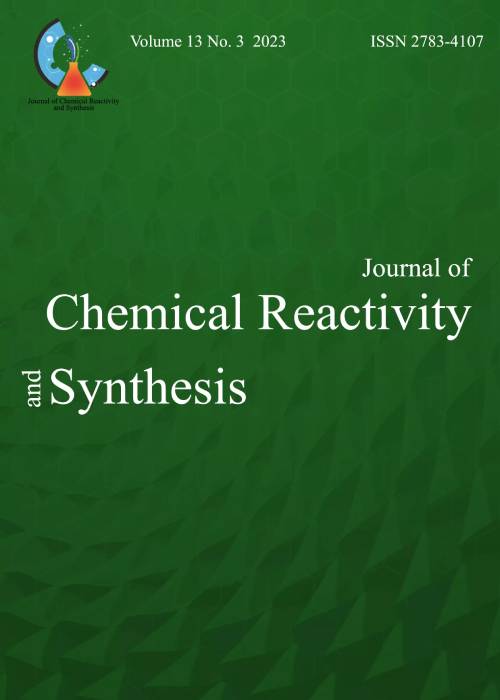فهرست مطالب
Journal of Chemical Reactivity and Synthesis
Volume:12 Issue: 4, Autumn 2022
- تاریخ انتشار: 1401/09/10
- تعداد عناوین: 6
-
Pages 232-238In the process of extracting chemical compounds from the extract of Cleome turkmena Bobrov, a flavonoid with a high weight percentage was extracted as pure green crystals. The compound was purified using several chromatographic and recrystallization methods and identified by crystallography and 1H, 13C NMR and it was determined that this flavonoid is Salvigenin with the scientific name 5-hydroxy-4',6,7-trimethoxyflavone. Also, according to the lot of reports about the antibiotic properties of flavonoids, the effect of Salvigenin on inhibiting the growth of several bacteria and fungi was investigated by minimal inhibitory concentration (MIC) and disk diffusion (DD) methods. The best inhibition against Bacillus pumilus with MIC value of 64 µg/ml. In disk diffusion method, best result was recorded against Salmonella typhi.Keywords: Flavonoids, Phytochemistry, Salvigenin, antibiotic
-
Pages 239-253Many studies have been conducted using electrochemical impedance spectroscopy (EIS) in recent decades. This is an accurate detection technique for electrochemical systems based on transmission function analysis between voltage and current. In this research, impedance, admittance, and capacitance of composite graphite electrode are investigated and compared in Mn and Fe ions solutions in sulfuric acid medium. The results indicated lower Fe impedance than Mn and admittance greater than that of Mn, indicating a greater Fe conductivity than Mn. Additionally, higher capacitance of Fe than of Mn was because of higher electric characteristics of Fe as compared to Mn. These techniques have been an alternative for cyclic voltammogram (CV) and mainly help in the quantitative determination of kinetic and transmission parameters. Valuable data are obtained using Electrochemical impedance spectroscopy (EIS). Therefore, it can be concluded that EIS is a detecting technique for describing and evaluating the behavior of intermediary elements at the surface of electrode/electrolyte.Keywords: Admittance, Capacitance, Cyclic voltammogram, Manganese(II) sulfate, Iron(II) sulfate
-
Pages 254-263
Electrosynthesis of zinc sulfide nanoparticles doped with copper and chlorine has been investigated in this study. For the electrosynthesis of ZnS, a constant current pulse of 200 mA cm-2 was applied to zinc nitrate and sodium thiosulfate solution containing 1 M hydrochloric acid in an electrochemical cell. The thin film of zinc sulfide nanoparticles was placed on a graphite electrode. For doping Cl- and Cu+ on ZnS, the modified electrode was placed in copper sulfate solution containing 0.1 M potassium chlorate under a constant potential of -0.9 V for 3 minutes. By changing the concentration of potassium chlorate from 0.1 to 0.01 and 0.0001 M, the amount of doped Cl was variable, therefore; nanoparticles with different luminescence properties were achieved. Based on the X-ray diffraction pattern average crystallite size for nanocomposites is the same and about 34-64 nm. Using scanning electron microscopy imaging it was observed that synthesized nanocomposites have appropriate uniformity. Characterization was performed using XRD and FT-IR methods. The morphology and luminescence properties of these nanoparticles were studied using SEM and UV-Visible.
Keywords: Electrosynthesis, Zinc sulfide, nanoparticles, Luminescence -
Pages 265-279In this work, simple and mild efficient synthesis of various organophosphorus compounds based on the reaction of dialkyl(aryl) phosphites with alkyl(aryl) propiolates in the presence of NaCN in aqueous acetone, is described. Organophosphorus compounds are widely used in organic synthesis, such as agricultural chemicals, flame retardants, medicinal agents and the preparation of insecticides. Using this approach, to a solution of alkyl(aryl) propiolates and dialkyl(aryl) phosphite was added sodium cyanide in acetone/H2O at room temperature, and the solution was stirred. The solvent was removed under reduced pressure, and the residue was dissolved in EtOAc, washed with aqueous NaHCO3 and brine, dried (Na2SO4), and the solvent was removed under reduced pressure. The crude product was purified by flash column chromatography on silica gel using n-hexane-EtOAc as eluent. Then, All organophosphorus compounds are obtained in excellent yields. The method offers several advantages including operational simplicity, high diversity via various functional groups and fairly good yields.Keywords: Vinylphosphonates, Dialkyl(aryl) phosphites, Alkyl(aryl) propiolates, Sodium cyanide
-
Pages 280-294In this article, nickel oxide and nickel ferrite nanoparticles were first synthesized using an ultrasonic method as a simple, fast, eco-friendly, and cost-effective method. To ensure the properties of the nanoparticles and to avoid problems in the following steps, the nanoparticles are synthesized under various analyzes such as scanning electron microscopy (SEM) images, infrared spectroscopy (IR), an X-ray diffraction pattern (XRD), and Vibrating sample magnetometry (VSM). In the next step, using these nanoparticles and epoxy resin, a polymer matrix composite was made. Then, the composites were tested for corrosion against acid and hardness tests based on the ASTM D2583-13 standard. The results showed that the structure of the manufactured nanoparticles is very uniform and homogeneous. In addition, the hardness of composites made from nickel ferrite and nickel oxide nanoparticles was improved compared to pure polymer, and composites made from nickel ferrite had better hardness than composites made from nickel oxide. Also, the acid corrosion test results showed that creating a composite layer around aluminum can protect it against acid corrosion.Keywords: Ultrasonic method, Nickel oxide, nickel ferrite, polymer matrix composite
-
Pages 295-308The Biginelli Reaction is a one-pot acid catalysed cyclocondensation of -keto ester, urea and aromatic aldehyde which leads to the synthesis of functionalised 3,4-dihydro-2(H)-pyrimidinones (DHPMs). This three-component reaction for the synthesis of dihydropyrimidinone and corresponding dihydropyrimidinethiones has now been known for more than a century since first reported in 1893. The classical reaction has been modified in the recent past by using various catalysts and several structural variants in different solvents to synthesize large number of Biginelli type compounds. Also, these DHPMs (synthetic and natural) possess a wide range of pharmacological activities.Keywords: Dihydropyrimidinone, dihydropyrimidinethione, Multicomponent reactions, Ag2O, GO, TiO2


